My kitchen used to be dull and empty. It had white walls, stainless steel, and no plants. But everything changed with one small herb plant. It turned my kitchen into a lively, colorful space.
Kitchen plants have changed how we see our kitchens. No more cold, empty spaces. Now, we have green, lush areas for cooking and making memories. From herbs on windowsills to vines hanging down, plants add life to our kitchens.
Adding plants to your kitchen is more than just making it look good. Plants clean the air and make us happier. They can match any kitchen style, from vintage to modern.
Don’t worry if you’re not good with plants. Cacti and golden pothos are easy to care for. And if you have little space, try hanging plants or using window sills. There are many ways to create a beautiful indoor garden.
Key Takeaways
- Plants purify air and improve mood in enclosed spaces
- Kitchen plants can define unique styles: vintage, industrial, or minimalist
- Low-maintenance options like cacti are great for beginners
- Hanging plants and window sill gardens save space
- Aromatic herbs serve dual purposes: decor and cooking
- Large plants can visually separate spaces in open kitchens
- Vertical gardens offer space-saving solutions for small kitchens
The Benefits of Incorporating Plants in Your Kitchen

Adding plants to your kitchen has many benefits. An indoor garden can turn your kitchen into a lively oasis. It improves air quality, reduces stress, and makes your kitchen cozy.
Houseplants not only look good but also have practical uses. They add color, texture, and interest to your kitchen. Plus, they can hide imperfections and update your space without breaking the bank.
Here are some ways to bring plants into your kitchen:
- Place taller plants to draw attention and infuse life
- Grow herbs on sunny windowsills for fresh cooking ingredients
- Adorn countertops with small potted plants for convenience
- Install wall planters to create a lush vertical garden
- Use tabletop centerpieces filled with vibrant flora
When picking kitchen plants, think about their size, light needs, and if they’re safe for pets. With the right care, your plants will flourish. This way, you can make your kitchen a peaceful spot while enjoying cleaner air and a natural touch in your cooking.
Choosing the Right Plants for Your Kitchen Environment

Choosing plants for your kitchen needs thought. Think about your space, light, and humidity. For small kitchens, pick tiny herbs or plants. Near sinks or stoves, choose plants that love moist air.
For kitchens with little sunlight, go for plants that don’t need much light. Safety is key too. If you have pets or kids, pick plants that are safe for them.
Some safe options include:
- Lemon Button Fern
- Orchids
- Calathea Concinna ‘Freddie’
- Jade Pothos
- Pearl Pothos
Edible plants like basil need lots of sunlight. For darker spots, try Boston Fern, Chinese Money Plant, or Devil’s Ivy. These plants do well in indirect light.
Make a statement with big plants. A large Ficus benjamina ‘Exotica’ can be striking. Monstera or Fiddle Leaf Fig are also great for bold looks. Place sun-loving plants near windows for best growth.
Match your pots to your kitchen’s style. Brass for modern, woven for rustic. Choose pots that let plants grow. Open shelving is perfect for showing off your plants.
Kitchen Plants Decor Ideas: Transforming Your Culinary Space

Ready to make your kitchen more lively? Plants can turn it into a vibrant oasis. A huge 78% of homeowners use plants as kitchen decor. Let’s dive into some fresh ideas to make your kitchen greener.
Windowsill gardening is all the rage. About 65% of homeowners grow plants on kitchen windowsills, using natural light. Try herbs like rosemary or thyme for a practical touch. For color, orchids thrive in kitchen humidity and add elegance.
Hanging plants are great for small kitchens. Trailing plants like Philodendron Cordatum can hang from cabinets, adding depth. For a unique look, consider air plants. They can hang anywhere, even in empty wine bottles!
Countertop plants are also popular. A surprising 42% of homeowners use them for easy greenery. Peperomia plants are perfect for small spaces, while a lush Calathea can thrive in low light areas. A large plant like a coffee tree can make a bold statement in a corner.
Looking for a natural divider in an open-plan kitchen? You’re not alone. About 48% of homeowners use large plants as subtle privacy screens. A hibiscus or a tall ficus can work well. Remember, creative plant arrangements can transform any space, even your bathroom!
With these ideas, you’re ready to turn your kitchen into a green haven. Happy planting!
Low-Light Plants Perfect for Kitchens with Limited Sunlight
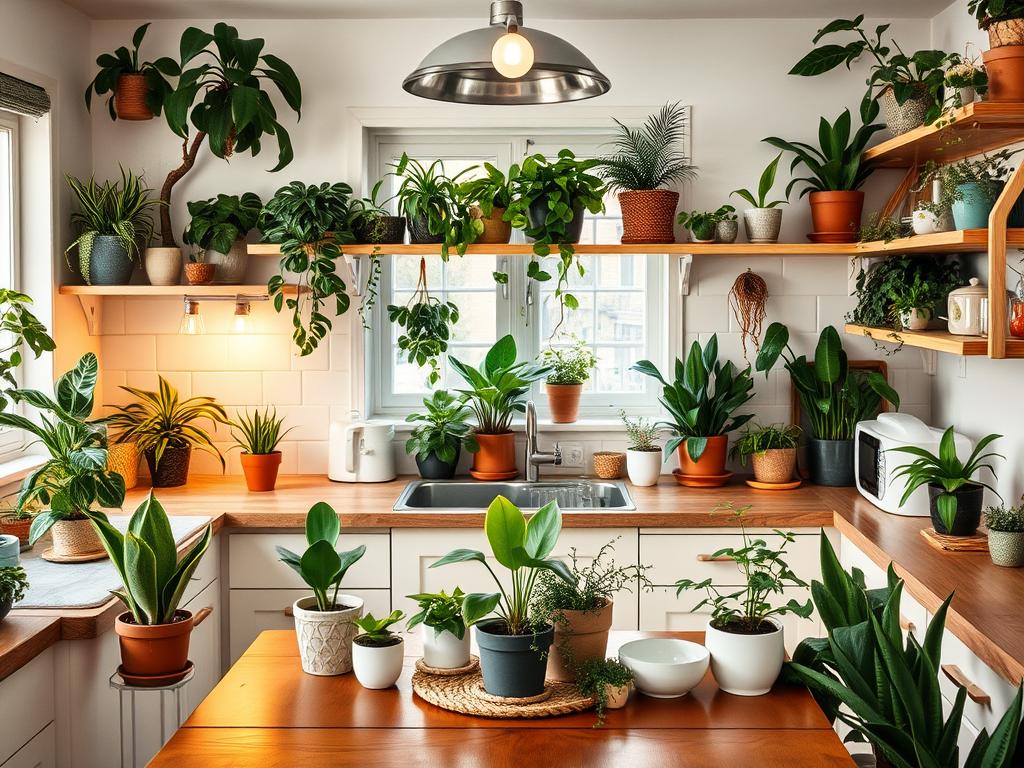
Kitchens with little sunlight can still have lush greenery. Plants that do well in low light can brighten up dark spots. Indoor tropical plants like the Snake Plant and ZZ Plant are great for these areas.
The Snake Plant is very tough and can go without water for up to three weeks. It’s easy to care for and adds green to your kitchen. The ZZ Plant also does well in no light at all.
Looking for more options? Here are a few:
- Pothos (Devil’s Ivy): Needs little care and likes low light
- Chinese Evergreen: Can handle low light and looks tropical
- Prayer Plant: Does well in low light but likes humid places like bathrooms
- Lucky Bamboo: Grows in low light but is toxic to pets, so keep it away
When picking plants for your kitchen, remember not to overwater. Let the soil dry out a bit before watering again to avoid root rot. With these plants, you can make your kitchen bright and green, even with little light.
Edible Plants to Grow in Your Kitchen

Turn your kitchen into a lush herb garden with plants that are perfect for growing on windowsills. These edible plants not only add fresh flavors to your meals but also make your kitchen come alive.
Begin your herb garden with these simple-to-grow options:
- Rosemary
- Oregano
- Sage
- Chives
- Mint
These herbs come back every year, making them easy to care for. Place them on a sunny windowsill for the best growth.
For a sweet touch, grow strawberries or blueberries in pots. These small fruits give lots of berries in summer. If you’re up for a challenge, try a dwarf citrus tree like yuzu for a unique flavor.
Leafy greens like lettuce and arugula grow fast. You can have fresh salads in just weeks. For a spicy flavor, grow chili peppers. They’re also great as houseplants.
Use rich soil and prune often to keep your garden healthy. With the right care, your kitchen garden will give you fresh ingredients all year. It will make your cooking better and brighten your kitchen.
Creative DIY Plant Displays for Kitchen Decor
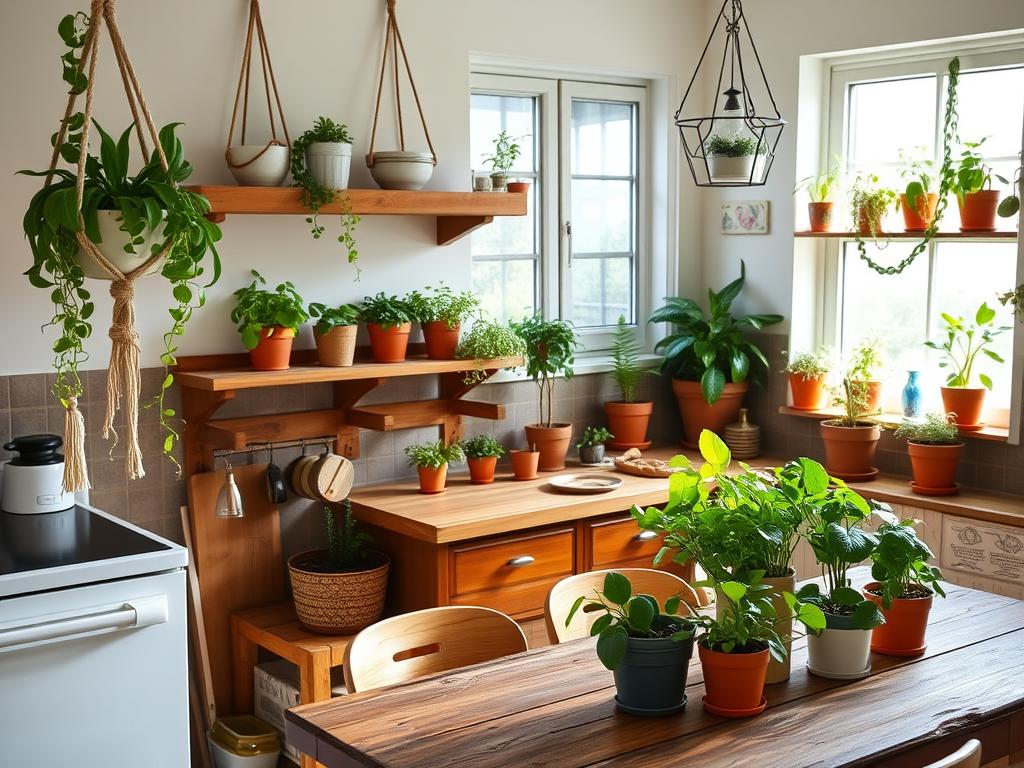
Turn your kitchen into a green paradise with DIY plant displays. Use everyday items to make unique planters. For example, turn a vintage colander into a hanging planter for herbs. Or, use mason jars for a rustic herb garden on your windowsill.
These projects not only make your kitchen look better but also give you fresh ingredients right there.
Hanging plants are great for small kitchens. Make macramé plant hangers to hang pothos or spider plants from the ceiling. This adds beauty and purifies the air. For a modern look, install floating shelves to show off small plants, making bare walls come alive.
Terrariums are perfect for kitchen islands or tables. Build one using glass containers, pebbles, activated charcoal, and succulents. These mini worlds need little care and bring nature to your kitchen. With some creativity, you can make plant displays that show off your style and refresh your kitchen.
- Repurpose colanders as hanging planters
- Create herb gardens using mason jars
- Make macramé hangers for ceiling plants
- Design terrariums for table centerpieces
DIY plant displays not only beautify your kitchen but also offer health benefits. Studies show plants can lower stress and boost mood. With more people using plants in their kitchens, it’s a growing trend. Get creative and bring nature into your kitchen today!
Vertical Gardens: Maximizing Space in Small Kitchens
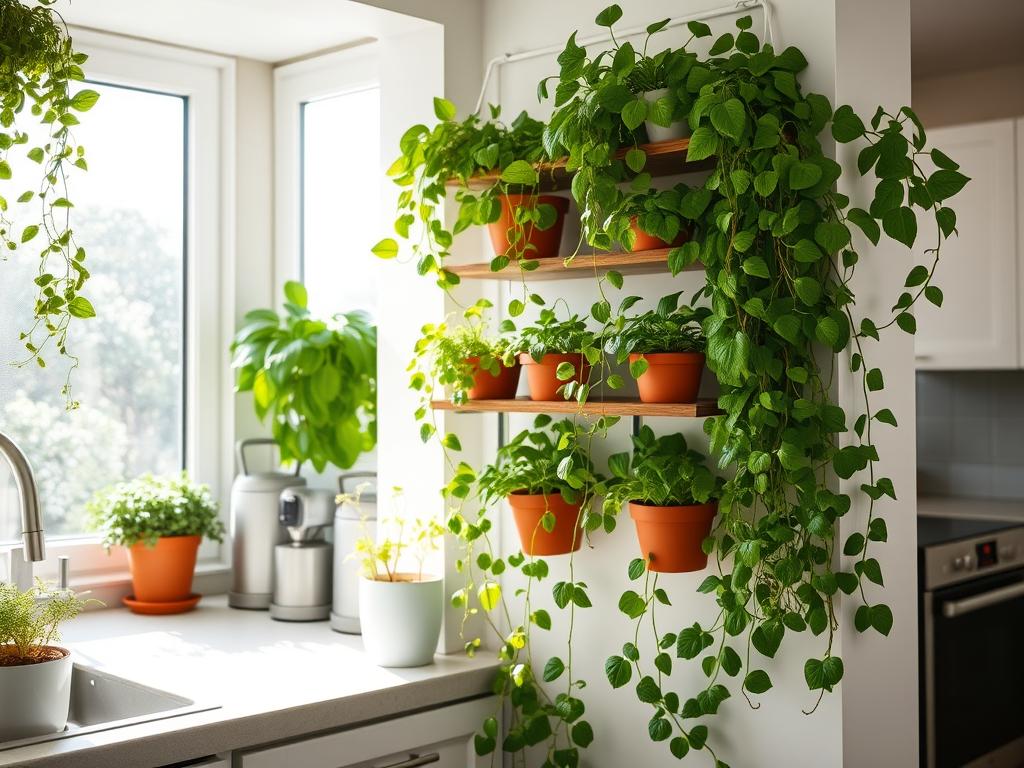
Small kitchens can really benefit from vertical gardens. These solutions save space, add greenery, and improve air quality. They also help reduce noise. By using wall planters and hanging plants, you can make your kitchen lush and eco-friendly. This is all without losing any floor space.
Vertical gardens offer many benefits:
- Promote healthier eating habits
- Reduce carbon emissions
- Lower ambient temperature
- Decrease electricity expenses
To set up a vertical garden in your kitchen, consider these ideas:
- Install modular planting systems on walls
- Use over-the-door organizers for compact herb gardens
- Hang plants from the ceiling
- Place small planters on window sills
Mix trailing plants with compact herbs for a varied look. This not only saves space but also makes your kitchen more interesting. Growing small veggies like tomatoes, peppers, and beans adds to your kitchen’s charm. It also gives you fresh ingredients for cooking.
Adding vertical gardens turns your small kitchen into a lively, useful space. It combines practicality with natural beauty.
Incorporating Terrariums and Mini Gardens in Kitchen Design
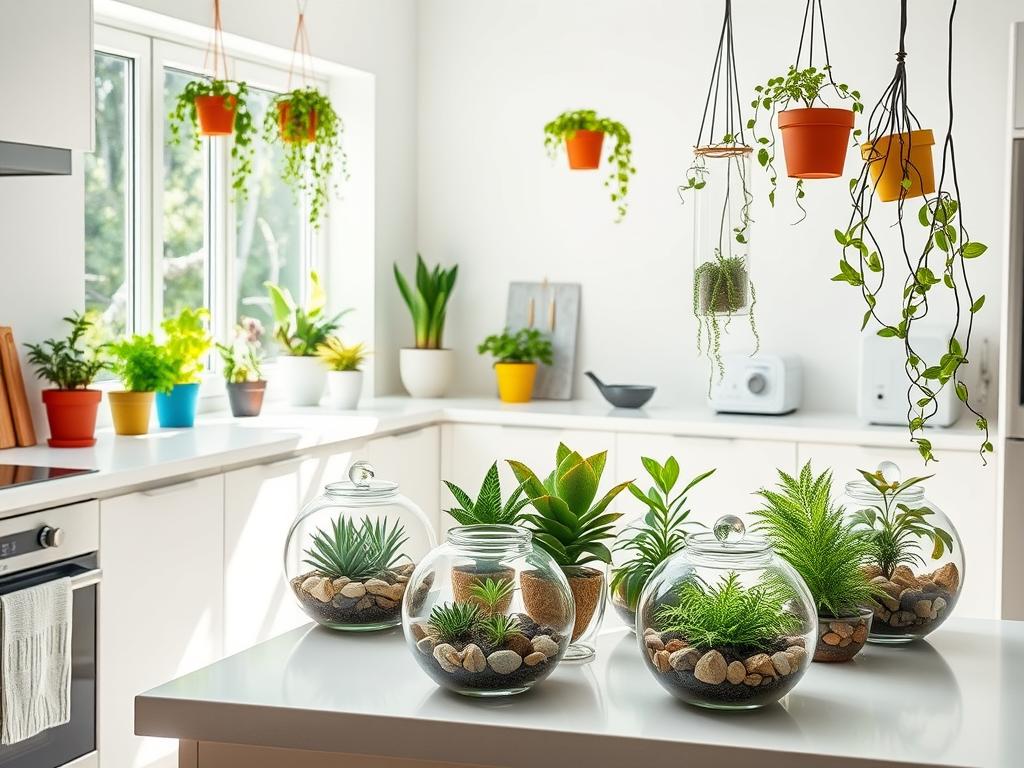
Make your kitchen more whimsical with terrariums and mini gardens. These glass containers hold tiny ecosystems that can sit on countertops or shelves. They add a special touch to your kitchen. Plus, terrariums are easy to care for, needing water only every four to six months.
Choose succulents, air plants, or small tropical plants for your terrarium. These plants love being in a closed space and look amazing. You can even create a themed mini garden, like a fairy garden or a herb garden. This adds beauty and usefulness to your kitchen.
Here are some creative ways to add terrariums and mini gardens to your kitchen:
- Place a terrarium centerpiece on your kitchen island
- Create a windowsill herb garden for fresh cooking ingredients
- Use hanging terrariums to maximize vertical space
- Design a succulent garden in a repurposed kitchen container
- Incorporate a mini tropical plant terrarium as a unique backsplash accent
Adding these tiny ecosystems can turn your kitchen into a lively, green space. Terrariums and mini gardens not only make your kitchen look better. They also help make your home healthier and more vibrant.
Using Plants to Create Natural Dividers in Open-Plan Kitchens
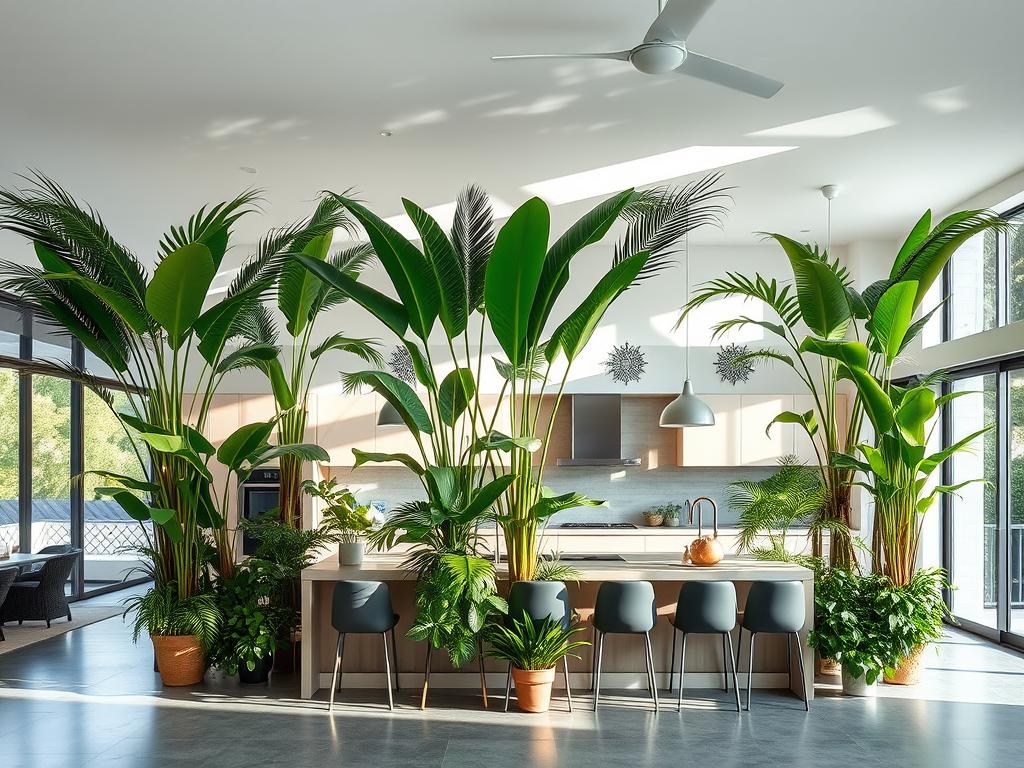
Open-plan kitchens are a hit in modern homes, with 60% of new builds having this layout. As more people want spaces that do it all, finding ways to separate areas is key. Plants are a chic way to do this, bringing life and color to your home.
Large houseplants are perfect for dividing open spaces. Place tall plants like Fiddle Leaf Figs or Bird of Paradise trees to subtly separate your kitchen and living areas. These plants not only mark boundaries but also purify the air and bring a lively feel to your space.
To make plants work as dividers, try these tips:
- Create a green screen with a mix of floor plants and hanging baskets
- Use different heights to add interest and define areas
- Put plants on shelves for a divider that also holds items
There’s been a 30% rise in people wanting to use plants as dividers. This trend blends function with fashion, offering a changeable alternative to solid walls. By picking the right plants, you can easily change your layout while enjoying nature indoors.
Maintenance Tips for Thriving Kitchen Plants
To keep your kitchen plants healthy, you need to care for them properly. Start by learning how much water each plant needs. Kitchen humidity can change soil moisture, so check it often. Also, dust leaves to help plants photosynthesize better.
Be careful of temperature changes near appliances. Plants like peace lilies and spider plants can handle different conditions. Move your plants around to ensure even growth. Use the right fertilizers during growing seasons to boost their health.
Keep an eye out for pests and treat them fast. This stops infestations and keeps your kitchen garden healthy. Remember, each plant has its own needs. For example:
- Snake plants filter out toxins like formaldehyde
- Pothos plants thrive in dimly lit areas
- ZZ plants adapt well to low-light conditions
By following these tips, you’ll have a thriving indoor garden in your kitchen. With the right care, your plants will not only look good but also improve the air and your mood.
Stylish Planters and Containers for Kitchen Aesthetics
Make your kitchen look better with stylish planters and containers. The right ones can change your kitchen, adding charm and personality. You can find many styles, from classic ceramic to modern metal, to match your taste and kitchen design.
Hanging baskets are great for adding greenery without taking up counter space. They’re popular, with 75% of kitchens using them. Wall-mounted planters are also good for saving space, especially in small kitchens or for a vertical garden look.
When picking planters, think about these:
- Self-watering pots for easy care
- Stacking planters for flexible setups
- Hand-crafted terracotta for a unique look
- Rattan pots for a boho style
- Illuminated planters for extra decor
Play with different sizes and styles to add interest. Match planter colors with your kitchen’s colors for a unified look. Don’t forget, good drainage is key to avoid water damage.
Use houseplants to draw attention. 67% of kitchens have standout plants like fiddle leaf figs or yuccas. For a modern feel, 80% of designers suggest grouping succulents in trays or small planters.
Follow these tips to boost your kitchen’s look with the right plants and planters.
Seasonal Plant Decor Ideas for Your Kitchen
Make your kitchen a lively indoor garden with seasonal decor. Change your houseplants decor as the seasons change. In spring, add flowering plants like orchids from the Orchidaceae family. These plants love high humidity, making them great for kitchens.
Summer is the time for tropical plants. Try adding a Pink Polka Dot Plant. It loves warm, humid air and bright, indirect light. For fall, use plants with warm colors to match the season. The Calathea Concinna ‘Freddie’ is a good choice, as it purifies the air and reduces stress.
Winter is perfect for evergreen plants and festive herbs. Rosemary is a great choice, growing well in bright light. It’s not just pretty; it’s also good for cooking. Rotate your plants with the seasons to keep your kitchen looking fresh and ensure they grow well.
- Use odd numbers (3 or 5) when arranging plants for visually appealing displays
- Incorporate different pot types to match your kitchen’s style
- Consider hanging plants like spider plants or pothos for vertical interest
- Prune regularly to maintain shape and remove dead leaves
Follow these seasonal decor tips to make your kitchen lively and inviting. It will change with the seasons, bringing nature indoors all year.
Combining Functionality and Beauty: Plants for Kitchen Organization
Plants can make your kitchen lively and useful. A survey showed 557 Pinterest users looked for plant ideas in kitchen cabinets. This shows more people want decor that’s also practical.
Make a herb garden on your kitchen wall for easy cooking access. It brings freshness to your meals and saves space. Vertical gardens are great for small kitchens, serving as spice racks or utensil holders. Plus, 14 plants do well in low light, perfect for kitchens with little sun.
Bigger plants can hide storage or appliances, adding beauty and keeping things useful. Hang plants to mark off kitchen areas, making the space flow better. For a beautiful centerpiece, add plants to your kitchen island. With 17 kitchen plant decor ideas, you’ll find something beautiful for your space.
Remember, caring for plants gets better with time. Start with easy plants like Snake Plants or Pothos. They like indirect light and can handle dry soil sometimes. Set a watering reminder on your phone for the best care. Soon, your kitchen will be both organized and green.
FAQ
What are the benefits of having plants in the kitchen?
Plants in the kitchen improve air quality and reduce stress. They also make the space look cozy and natural. Some plants, like ferns, are great at cleaning the air.
How do I choose the right plants for my kitchen environment?
Think about your kitchen’s size, light, and humidity. For small kitchens, pick compact plants or herbs. Choose plants that like humidity near sinks or stoves.
For little light, pick plants that don’t need much sun. Make sure plants are safe for pets or kids by picking non-toxic ones.
What are some creative ways to incorporate plants into my kitchen decor?
Use windowsills for herbs or small plants. Hang plants from cabinets or make a living wall. Place big plants in corners or on fridges.
Use plants to divide spaces in open kitchens. Mix flowers and green leaves for a nice look.
What are some good low-light plant options for kitchens with limited natural light?
For little light, choose plants like Snake Plants, ZZ Plants, Chinese Evergreen, and Jade and Pearl Pothos. These plants do well in indirect light.
How can I grow fresh herbs and edible plants in my kitchen?
Grow herbs like Rosemary, Thyme, Marjoram, Basil, and Microgreens. They’re great for cooking and look nice. Put them on sunny windowsills or in small planters.
What are some creative DIY plant display ideas for the kitchen?
Use old items like colanders or mason jars as planters. Make hanging planters from macramé or a living wall with a pallet. Try a terrarium as a kitchen centerpiece.
How can I maximize vertical space in a small kitchen with plants?
Use wall-mounted planters or a living wall for space-saving. Hang plants from the ceiling or use over-the-door organizers for herbs. Vertical gardens save space and look great.
What are terrariums and mini gardens, and how can I incorporate them into my kitchen?
Terrariums are glass containers with plants, perfect for shelves. Use succulents or small tropical plants. Mini gardens, like fairy gardens, add a unique touch to your kitchen.
How can I use plants to create natural dividers in an open-plan kitchen?
Use big plants as dividers in open kitchens. Place tall plants like Fiddle Leaf Fig in key spots. Mix floor plants with hanging baskets for a green screen.
What maintenance is required for kitchen plants?
Keep plants healthy with the right care. Know their watering needs, as kitchen humidity affects soil. Dust leaves to help plants photosynthesize.
Watch temperature near appliances and rotate plants for even growth. Use the right fertilizer and check for pests often.
How do I choose stylish planters and containers for my kitchen plants?
Pick planters that match your kitchen’s style. Ceramic pots are classic, while metal is industrial. Hang baskets save space and wall planters are space-efficient.
Match planter colors with your kitchen. Mix sizes and styles for interest. Make sure planters have drainage to avoid water damage.
How can I incorporate seasonal plant decor in my kitchen?
Change your kitchen plants with the seasons. Spring is for flowering plants like orchids. Summer is for lush plants.
Fall has warm-colored foliage, and winter is for evergreen plants and festive herbs. Rotate plants for a fresh look and best growing conditions.
How can I use plants for both decorative and functional purposes in my kitchen?
Use plants for looks and function. Make an herb wall for easy cooking access. Hang plants to mark kitchen zones.
Use plants in your island design for a natural centerpiece. Big plants can hide storage or appliances. Try a vertical garden that’s also a spice rack or utensil holder.
